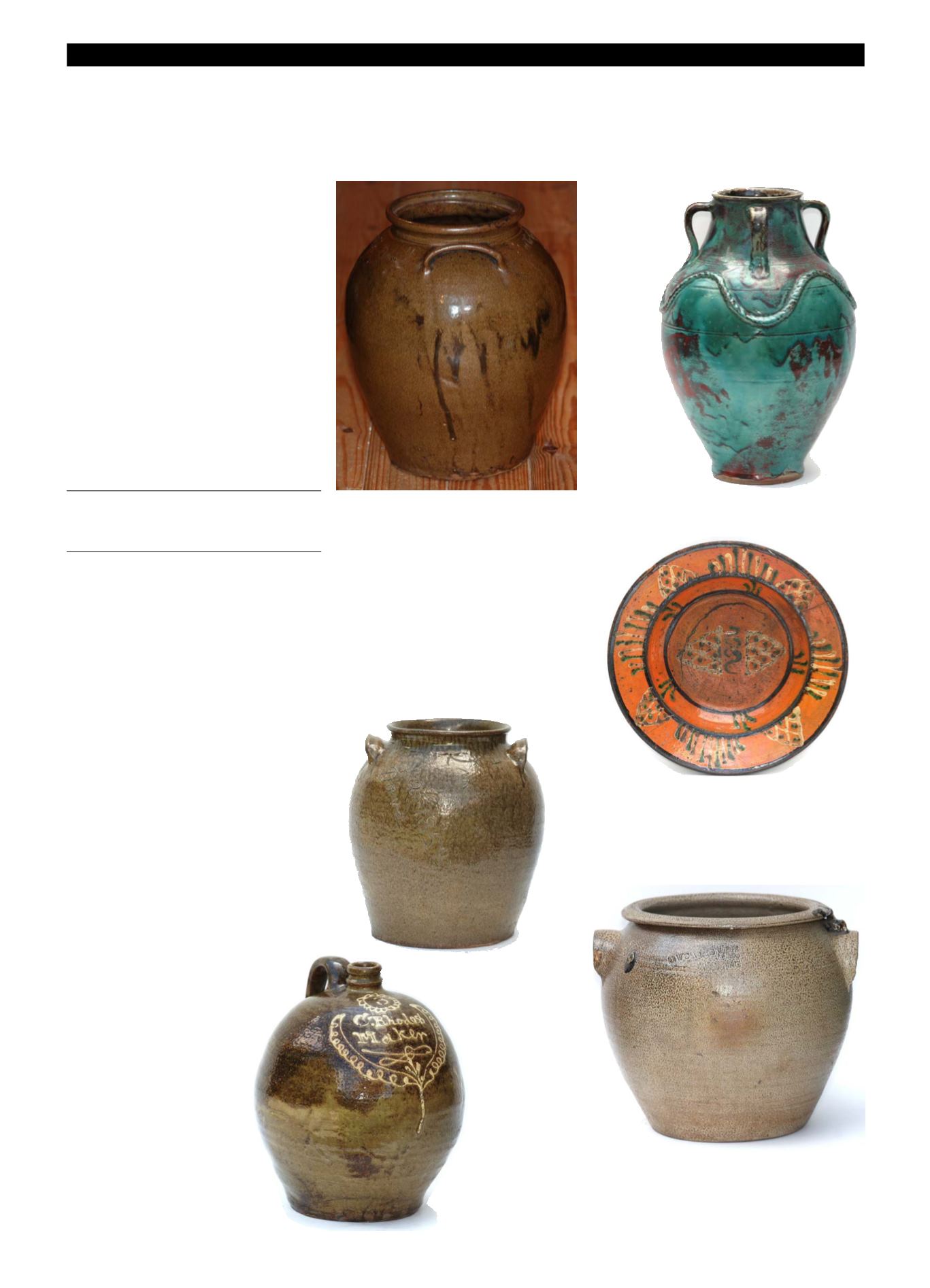

24-C Maine Antique Digest, April 2017
-
AUCTION -
24-C
The average collector looks for
interesting, curious, unusual, or
mainstream items at fair prices.
Southern Folk Pottery Collectors Society, Bennett, North Carolina
Southern Folk Pottery Sale
by Marty Steiner
Photos courtesy Southern Folk Pottery Collectors Society
A
pproximately twice a year the Southern Folk
Pottery Collectors Society (SFPCS) sends
out a publication about southern history and
geography in the form of a spiral-bound absentee
pottery auction catalog. The 46th SFPCS sale, which
closed on November 5, 2016, was a little larger than
other SFPCS absentee sales, with over 400 lots. Two
things that always set these auctions apart from others
are the number of authentic older, historic, and iconic
pieces offered and the amount of detail describing and
providing provenance and context for each piece. There
is always a wealth of reference material identified that is
relevant to each example offered.
With an emphasis on the study and research into the
history, techniques, and technology of southern pottery,
this sale featured items from the Howard A. Smith
study library collection. Smith is widely known for
his essential
Index of Southern Potters
(1982), a 222-
page listing of three centuries of potters, by states, with
extensive biographical material on each. Smith visited
each of the potters still living at the time to develop his
information. This publication has served decades of
collectors and historians with information such as the
potter’s process, glazes, and other details. It is the basic
and essential reference to southern pottery.
Fifty-three lots of books and photographs from
Smith’s study collection, each with two to seven items,
were offered. In addition to the value of their contents,
these items from Smith’s personal library are a link
to this notable individual. Every book lot included a
copy of Smith’s landmark
Index of Southern Potters
.
The Smith lots sold for prices ranging from just $22
(the minimum stated bid for those lots) for a group of
three books and for another three-book lot that featured
Michael Cardew’s
Pioneer Pottery
to a high of $247.50
for three books focusing on Texas pottery. (All prices
include the 10% buyer’s premium.) Many of these book
lots included unique unpublished studies.
As always, the sale items were organized
alphabetically by state and grouped by special potting
areas within the state. South Carolina, North Carolina,
and Georgia provided the bulk of the lots, but there were
contributions from nearly every southern state.
Among the six Alabama offerings was an unusual,
rarely seen form. Although face jugs and pitchers of
many styles and from diverse sources are seen, only
four open-top face planters are known. One of them
attributed to the Norman Smith shop exceeded its
estimate and sold for $3080.
Two early Georgia production areas were Washington
and Crawford Counties. A bulbous Washington County
two-handled storage jar reached $385. Two Crawford
County pots included a late 19th-century Columbus
Becham two-handled beehive jug at $1650 and a first-
ever-seen signed single-handled jug by Henry Averett,
third quarter of the 19th century, signed “AH,” that
reached only $522.50.
At $28,600, a pot by the enslaved potter Dave
won top honors again. It has an unusual “Mister
Miles” signature rather than the usual “LM”
markings and was perhaps a commemorative
piece as it also bears a date, “October 15 –
1849.” This five-gallon storage jar with
two lug handles was described in the
catalog as a jardinière because of its
upper rounding.
The other pot by Dave in this sale
was signed and dated vertically
“Dave Decm 21 – 1859.” This
vertical signature coupled with a
scarce mottled alkaline glaze rather
than his usual slick, glossy, smooth
finish made this an unusual example.
Its price was somewhat disappointing
at only $14,300, well below the low
estimate of $20,000.
BenOwen I, whoworked at the Jugtown
Pottery in the Jacques and Julianna Busbee
era of the 1930s, produced Oriental and
Any pot by the renowned enslaved potter known as
Dave the Slave is rare and valuable. Examples with
verse top the charts, with most bearing the “LM” mark
of Lewis Miles, Dave’s owner. This example, typical in
form, handles, and every other aspect of a Dave pot, is
signed “Mister. Miles Dave” for some unknown reason.
It was the sale’s top lot at $28,600, somewhat below its
$30,000/40,000 estimate.
Exhibiting strong
Chinese blood-red
and turquoise-blue
glazes, this Ben Owen
I four-handled Persian
jar sold for $22,550. The
shape and glaze as well as
the “JUGTOWN WARE” signature
suggest that it dates to the 1930s or early 1940s.
Most redware seen in the SFPCS sales is from
North Carolina, primarily from the Salem area,
and frequently produced by the potters of that
area who descended from German immigrants.
Many of the examples are decorated with
colored slip under a red lead glaze. Attributed
to Solomon Loy in the 1840s or 1850s, this plate
decorated in three colors drew heavy bidding
and reached $19,800.
With professional rim restoration, this
dated Dave storage jar features an
unusual glaze. Signed “Dave Decm 21
– 1859 LM X,” it sold for a respectable
$14,300.
The SFPCS catalog said that additional
research needs to be done about the origin
and maker of this particularly early (circa
1820) Edgefield, South Carolina, single-
handled jug that brought $3850.
A scarce, somewhat bloated-
looking one-handled jug
signed “C Rhodes Maker”
in kaolin slip sold for $14,850.
This example has an extensive
exhibition history.











